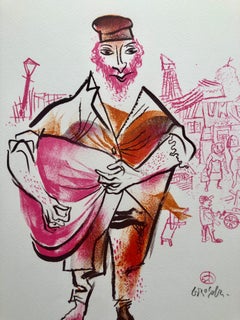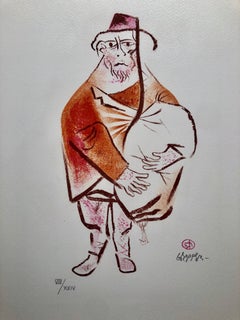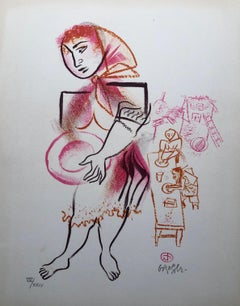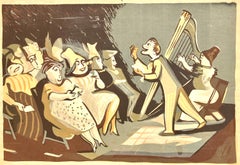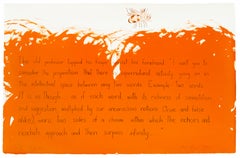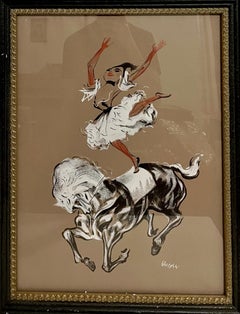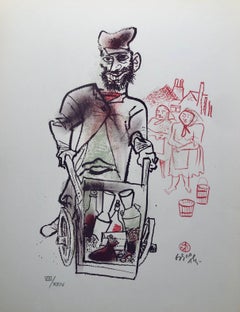William Gropper Figurative Prints
William Gropper was a painter and cartoonist who, with caricature style, focused on social concerns. Gropper was born on December 3, 1897, in New York. William Gropper was a student of Robert Henri and George Bellows at the Ferrer School from 1912–15. During the 1930s, working as a part of the Federal Arts Project, he produced some of the most gripping social protest works of the Great Depression. His subjects included industrial strikes, especially in coal mining and steel-production centers. Gropper did much illustration-cartoon work for the New York Tribune newspaper, Vanity Fair magazine and the politically left-wing publication, New Masses. Some of his other pieces focused on the hypocrisy of government figures, especially members of the United States Senate. Gropper died on January 6, 1977, in Manhasset.
Mid-20th Century American Realist William Gropper Figurative Prints
Lithograph
Mid-20th Century Modern William Gropper Figurative Prints
Lithograph
Mid-20th Century Modern William Gropper Figurative Prints
Lithograph
Mid-20th Century Modern William Gropper Figurative Prints
Lithograph
1930s Ashcan School William Gropper Figurative Prints
Screen
Mid-20th Century American Realist William Gropper Figurative Prints
Lithograph
Mid-20th Century Modern William Gropper Figurative Prints
Lithograph
Mid-20th Century Modern William Gropper Figurative Prints
Lithograph
1940s William Gropper Figurative Prints
Lithograph
Mid-20th Century Modern William Gropper Figurative Prints
Lithograph
Mid-20th Century Modern William Gropper Figurative Prints
Lithograph
Mid-20th Century Modern William Gropper Figurative Prints
Lithograph
1970s American Realist William Gropper Figurative Prints
Archival Paper, Lithograph
1970s Pop Art William Gropper Figurative Prints
Lithograph
Late 20th Century Impressionist William Gropper Figurative Prints
Lithograph
1980s Contemporary William Gropper Figurative Prints
Lithograph, Screen
1960s Modern William Gropper Figurative Prints
Lithograph
20th Century William Gropper Figurative Prints
Lithograph
2010s Other Art Style William Gropper Figurative Prints
Lithograph
Early 2000s Contemporary William Gropper Figurative Prints
Lithograph
2010s American Impressionist William Gropper Figurative Prints
Screen
Early 2000s American Impressionist William Gropper Figurative Prints
Screen
Early 2000s American Impressionist William Gropper Figurative Prints
Screen
Early 2000s American Impressionist William Gropper Figurative Prints
Screen
Mid-20th Century American Modern William Gropper Figurative Prints
Screen, Lithograph
Mid-20th Century Modern William Gropper Figurative Prints
Lithograph
Mid-20th Century Modern William Gropper Figurative Prints
Lithograph
Mid-20th Century Modern William Gropper Figurative Prints
Lithograph
1970s William Gropper Figurative Prints
Lithograph
Mid-20th Century Modern William Gropper Figurative Prints
Lithograph
Mid-20th Century Modern William Gropper Figurative Prints
Lithograph
Mid-20th Century Modern William Gropper Figurative Prints
Lithograph
Mid-20th Century Modern William Gropper Figurative Prints
Lithograph
Mid-20th Century Modern William Gropper Figurative Prints
Lithograph
Mid-20th Century Modern William Gropper Figurative Prints
Lithograph
Mid-20th Century Modern William Gropper Figurative Prints
Lithograph
